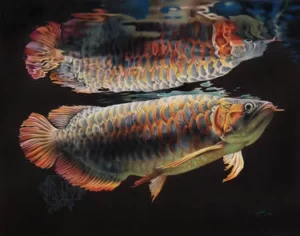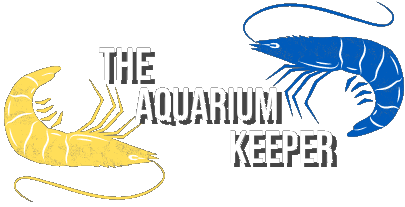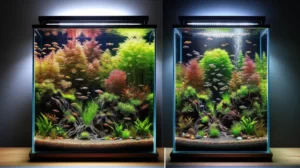
5 Best Fish for Your 3-Gallon Tank

Writer at The Aquarium Keeper
Keeping a fish tank is a fun hobby, but not everybody has the space or the finances to keep a big aquarium. If you are looking into getting a smaller aquarium, fortunately, there are some amazing fish species that are suited for smaller tanks. Keep reading to find out which species you can keep in a 3-gallon tank!
General Rules For Keeping a 3-Gallon Aquarium
Before getting into the species you can keep in a small tank, it is important to understand some basic rules that come with keeping fish in small volumes of water. There are certain things that you need to do when setting up your aquarium, and when maintaining it. Here are the general guidelines you need to follow if you want a 3-gallon aquarium:
- Use live plants. Forget the plastic or silk fake plants, use real ones! Real live plants provide a lot of benefits to fish, they also help filtrate the aquarium water and somewhat replicate fish’s natural habitat.
- Filtration is needed. Since there is so little amount of water, you must have a filter in your aquarium. Your chosen fish will create toxic waste, which needs to be filtered out in order for your fish to stay healthy.
- Don’t overstock your aquarium. As mentioned before, fish will create waste, and if you have too many fish in 3 gallons of water, it can quickly become dirty and hurt the well-being of your beloved pets.
- Perform weekly water changes. Smaller aquariums tend to get dirty faster, which is why you need to do regular water changes. Do at least 20% water changes every week.
These general guidelines need to be followed, otherwise, there is a higher chance that your fish might not be as healthy living in a 3-gallon tank as it should be.
Best Fish For 3-Gallon Tank
Before getting into the list of species, I want to mention that I also included creatures like shrimp and snails in this list, simply because not so many fish can live in very tiny aquariums. Nevertheless, every discussed species are a great option for a 3-gallon tank, and you should consider all of them.
Neocaridina Shrimp
Technically, shrimp are not fish, but I insisted on including this option in this article since shrimp is very amazing and can definitely live in smaller water volumes. Neocaridina is freshwater shrimp that are great for beginners to keep in a 3-gallon. The shrimp’s small size and low maintenance requirements make it a great choice for a small aquarium.

If you are planning on keeping neocaridina shrimp, you should know that these species come in a lot of different colors, which can be excellent for your small aquarium. To ensure that neocaridina shrimp have the best life in your tank, follow these guidelines:
| Aspect | Information |
|---|---|
| Scientific Name | Neocaridina davidi |
| Common Name | Cherry Shrimp |
| Origin | Asia |
| Rarity | Common |
| Price | $2 - $5 USD |
| Care Level | Easy |
| Water Temperature | 15–30 °C (59–86 °F) |
| pH | 6.5 - 8.0 |
| Minimum Tank Size | 3-5 gallons |
| Diet | Detritus, algae, and commercial shrimp food |
| Temperament | Peaceful |
| Lifespan | 1.5 - 2 years |
| Size | 1 - 1.5 inches |
Shrimp are very easy to take care of. They produce very little waste, so it is a perfect pet for a 3-gallon tank. Shrimp also reproduce very easily. Be sure to have some hiding places and live plants in your aquarium, since it replicates the natural environment of cherry shrimp.
Chili Rasboras
Chili rasboras are beautiful little fish that stay small. They have red bodies and a beautiful dark blue stripe that goes from head to tail. These species can be very shy due to their size.

This fish is best kept in small groups of their own kind, but if you plan to keep them in a 3-gallon, a group of 5-6 of them would be the maximum. Just like any other fish species, chili rasboras need to be properly taken care of. If you want your fish to live in the best environment, follow these guidelines:
| Aspect | Information |
|---|---|
| Scientific Name | Boraras brigittae |
| Common Name | Chili Rasbora |
| Origin | Malay Peninsula, Borneo, and Sumatra |
| Rarity | Common |
| Price | $3 - $5 USD |
| Care Level | Easy |
| Water Temperature | 22°C - 28°C (72°F - 82°F) |
| pH | 6.0 - 7.5 |
| Minimum Tank Size | 3 - 5 gallons |
| Diet | Small live and frozen foods, micro-pellets |
| Temperament | Peaceful |
| Lifespan | 2 - 4 years |
| Size | 0.75 - 1 inch |
Chili rasboras can be extremely shy at the beginning. If possible try to create some hiding spots in their aquarium, as well as include live plants that will provide extra cover wherever they swim.
Endler's Livebearers
Endlers are very hardy and beautiful fish. Males tend to be very colorful, while females are more grey and brown in color. These species are very active and can be interactive once they adjust to their surroundings. Endlers always beg for food, which is just adorable to see.

It is also important that you keep 1 male with 2 females or just 3 females in general. Males tend to fight over females, which is why you can only keep 1 male with females in a 3-gallon tank. Even though endlers are hardy species, they need certain tank conditions to thrive in their environment. Follow these guidelines to ensure their best health:
| Aspect | Information |
|---|---|
| Scientific Name | Poecilia wingei |
| Common Name | Endler's Livebearer |
| Origin | Venezuela |
| Rarity | Common |
| Price | $3 - $8 USD |
| Care Level | Easy |
| Water Temperature | 24°C - 28°C (75°F - 82°F) |
| pH | 7.0 - 8.0 |
| Minimum Tank Size | 3 - 5 gallons |
| Diet | Flakes, live, and frozen foods |
| Temperament | Peaceful |
| Lifespan | 1 - 2 years |
| Size | 1 - 1.5 inches |
Endlers also breed a lot and reproduce easily and often, so be sure to have a backup plan when that happens in your tank. You can sell new endler babies in the local market or gift them to somebody, just be sure your tank does not get overcrowded.
Galaxy Rasboras
Galaxy rasboras have one of the best looks in the fish hobby. Their dotted body combined with orange fins makes them very unique species. Galaxy rasboras are very active fish, that can also sometimes be shy due to their size.

Galaxy rasboras are also very friendly fish, that can be kept with other small aquarium fish, although it is best not to push your limits in a 3-gallon tank and only keep them. These species are hardy, but every fish have their own personal best surroundings, that fit them the best. To ensure that your galaxy rasboras are happy, follow these guidelines:
| Aspect | Information |
|---|---|
| Scientific Name | Danio margaritatus |
| Common Name | Celestial Pearl Danio or Galaxy Rasbora |
| Origin | Myanmar (Burma) |
| Rarity | Common |
| Price | $5 - $10 USD |
| Care Level | Intermediate |
| Water Temperature | 20°C - 26°C (68°F - 79°F) |
| pH | 6.5 - 7.5 |
| Minimum Tank Size | 10 gallons |
| Diet | Small live and frozen foods, high-quality flakes |
| Temperament | Peaceful |
| Lifespan | 3 - 5 years |
| Size | 0.75 - 1 inch |
Galaxy rasboras need to live in small groups with their own kind. They don’t particularly “school” like other nanofish, but they love to be with other galaxy rasboras. In a 3-gallon tank, you can keep a maximum of 3 galaxy rasboras.
Nerite Snails
Snails are also not fish, but they produce very little waste and can sometimes be very fun to watch. Snails are one of the most peaceful creatures in the aquarium hobby, especially nerite snails. Nerites come in a lot of different looks, which means you can find the one that fits you the best.

Nerites are very peaceful creatures, who will do no harm to any other living being in an aquarium. They are excellent for smaller tanks since they really don’t take up much space and don’t require a lot. Here are the requirements for nerite snails:
| Aspect | Information |
|---|---|
| Scientific Name | Neritina spp. (various species) |
| Common Name | Nerite Snail |
| Origin | Various species found in oceans and freshwater habitats |
| Rarity | Common |
| Price | $2 - $5 USD |
| Care Level | Easy |
| Water Temperature | 18°C - 28°C (64°F - 82°F) |
| pH | 7.5 - 8.5 |
| Minimum Tank Size | 5 gallons |
| Diet | Algae, biofilm, and leftover fish food |
| Temperament | Peaceful |
| Lifespan | 1 - 3 years |
| Size | 0.5 - 1 inch |
Nerite snails are known for laying eggs all over the aquarium: on rocks, glass, driftwood, and other decorations. But it is important to know, that they can’t reproduce in a freshwater aquarium, so you do not need to be worried about population explosion.
Writer's Thoughts And Personal Experience
All of the species mentioned above are great choices for a beginner. Personally, I believe that 3 gallons can be on the lower end when it comes to water volume, but it is still manageable and fish can be kept. Just be sure to do a lot of maintenance and research on a certain species before buying it.

Thank you for reading my blog post. This website was created with the sole intention of providing quality information regarding fishkeeping. I have been in the fishkeeping hobby for 8 years, and through many trials and errors as well as online research I gathered a lot of information, which I want to give back to the community.





